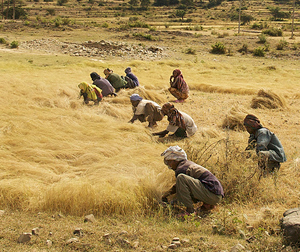Share This
We talk to a lot of journalists, and one of the questions they ask us most is, “What’s the next quinoa?” It’s hard to predict follow-ons for trends that are inexplicable in the first place – can you predict who will be the next Donald Trump, or the next Khloe Kardashian, after all? – but that doesn’t stop us from putting in our two cents. Lately when we get the “next quinoa” question, we answer “teff.”
Teff is the tiniest of all grains, similar In size to poppy seeds. Native to the horn of Africa, it’s an important staple in countries like Ethiopia and Eritrea, where it has several advantages. First, it suits the traditional nomadic lifestyle of the region, since a mere handful of the grain can sow an entire field. Second, teff thrives in both waterlogged soils and during droughts, and it’s relatively free of plant diseases compared to other crops. Best of all, it has some important nutritional plusses: it’s a good source of calcium (a cup of cooked teff has about the same amount as a half cup of cooked spinach) and loaded with resistant starch, a type of dietary fiber that can benefit blood-sugar management, weight control, and color health.
“Wait a minute,” I hear you say. “I’ve never even heard of teff!” Maybe not. Most of us first encounter it in spongy injeera bread at an Ethiopian restaurant. It’s not in many products yet (just under 1% of Whole Grain Stamp products include teff in the ingredients), nor on many menus outside of restaurants serving Ethiopian food.
This seems about to change. According to SPINS, sales of teff rose 58% from mid-2013 to mid-2014. The National Restaurant Association’s 2015 “What’s Hot” survey of trends showed chefs ranking “ethnic flour (e.g. fufu, teff, cassava/yucca)” at #39 among two hundred trends. And news headlines like “Will Ethiopia’s teff be the next super grain?” (BBC) “Is teff the new superfood?” (Huffington Post) and “Global craving for ancient Ethiopian grain” (Al-Jazeera America) are popping up everywhere.
So if teff becomes popular worldwide, will it do so at the expense of struggling families in Ethiopia? This has been a concern with quinoa for many people: as demand rose in Europe and the US, farmers in the Andes, where most of the world’s quinoa is grown, saw their incomes rise. But their poor compatriots in the cities of Peru and Bolivia became hard-pressed to afford the quinoa they’d always relied on as a dietary staple. (We like the Slate’s balanced account on this topic.)
Fortunately, rising demand for teff could be met right here in the US – unlike quinoa, which is mostly grown in the Andes. Oregon State University agronomist Rich Roseberg estimates about 11,000 acres of teff are grown in Oregon and Washington (largely for animal feed now) while in Idaho, Wayne and Elisabeth Carlson, at The Teff Company, work with local farmers to grow teff for human consumption.
In fact, to avoid the “quinoa situation,” the Ethiopian government for many years maintained an export ban on teff, to make sure that its citizens got first dibs on this essential grain. (According to a 2013 FAO report titled “Analysis of Incentives and Disincentives for Teff in Ethiopia,” teff accounts for about 11% of Ethiopians’ calories overall, and up to 30% in urban areas.) Earlier this year, however, the Ethiopian government announced it’s lifting the export ban to allow teff flour – but not intact teff grain – to be exported.
We’ll be happy if teff is “the next quinoa” on our tables – but disheartened if Chinese and Indian companies leasing swaths of cheap farmland in Ethiopia benefit from the lifting of the export ban while Ethiopia’s citizens and small farmers go hungry. We’re hoping that both supply and demand grow in tandem here in the U.S. so that we can all feel good about cooking up a dish of teff.
Want to try a few recipes, buy some teff, or learn more about teff? Teff and millet are our Grains of the Month in November. (Cynthia)


Add a Comment